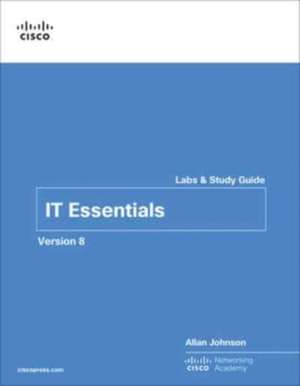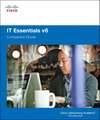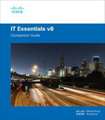IT Essentials Labs and Study Guide Version 8: Companion Guide
Autor Cisco Networking Academyen Limba Engleză Paperback – 20 noi 2023
IT Essentials Lab Manual is a supplemental book prepared for students in the Cisco� Networking Academy IT Essentials v8 course. All the hands-on labs and worksheets from the course are printed within this book to provide practical, hands-on experience with the course content. IT Essentials covers fundamental computer and career skills for entry-level IT jobs. Practicing and performing all these tasks will reinforce the concepts, skills, and procedures and help prepare the student to take the CompTIA� A+ 220-1101 and 220-1102 exams.
Each chapter of this book is divided into a Study Guide section followed by a Lab section.
The Study Guide section offers exercises that help you learn the concepts, configurations, and troubleshooting skills crucial to your success as a CompTIA� A+ 220-1101 and 220-1102 exam candidate. Each chapter is slightly different and includes some or all the following types of exercises:
- Vocabulary Matching Exercises
- Concept Questions Exercises
- Skill-Building Activities and Scenarios
- Packet Tracer Exercises
Related titles:
IT Essentials Companion Guide, Version 8
ISBN-10: 0-13-816610-2
ISBN-13: 978-0-13-816610-6
Preț: 326.36 lei
Preț vechi: 407.96 lei
-20% Nou
Puncte Express: 490
Preț estimativ în valută:
62.47€ • 67.88$ • 52.51£
62.47€ • 67.88$ • 52.51£
Carte disponibilă
Livrare economică 31 martie-14 aprilie
Livrare express 15-21 martie pentru 62.88 lei
Preluare comenzi: 021 569.72.76
Specificații
ISBN-13: 9780138166304
ISBN-10: 0138166307
Pagini: 576
Dimensiuni: 217 x 276 x 30 mm
Greutate: 1.3 kg
Editura: Pearson Education (US)
Seria Companion Guide
ISBN-10: 0138166307
Pagini: 576
Dimensiuni: 217 x 276 x 30 mm
Greutate: 1.3 kg
Editura: Pearson Education (US)
Seria Companion Guide
Notă biografică
Cisco Networking Academy is an innovative Cisco education initiative that delivers information and communication technology skills to improve career and economic opportunities around the world. The Academy provides online courses, interactive tools, and lab activities to prepare individuals for information technology and networking careers in virtually every industry.
Cuprins
Introduction xxxiv
Chapter 1 Introduction to Personal Computer Hardware 1
Study Guide 2
Personal Computers 2
PC Components 3
Computer Disassembly 21
Labs and Activities 22
1.3.2.1 Lab Safety 23
Objectives 23
Background / Scenarios 23
Suggested Resources 23
Instructions 23
Reflection Questions 26
1.3.2.3 Lab Disassemble a Computer 27
Introduction 27
Recommended Tools 27
Instructions 27
Chapter 2 PC Assembly 33
Study Guide 34
Assemble the Computer 34
Labs and Activities 44
Command Reference 44
2.1.2.5 LabInstall the Power Supply 45
Introduction 45
2.1.3.10 LabInstall the Motherboard in a Computer 46
Introduction 46
2.1.4.7 LabInstall the Drives 48
Introduction 48
2.1.5.6 LabInstall Adapter Cards 49
Introduction 49
2.1.7.4 LabInstall Internal Cables 51
Introduction 51
2.1.7.8 LabInstall Front Panel Cables 53
Introduction 53
2.1.7.11 LabComplete the Computer Assembly 54
Introduction 54
Chapter 3 Advanced Computer Hardware 55
Study Guide 56
Boot the Computer 56
Electrical Power 58
Advanced Computer Functionality 59
Computer Configuration 71
Protecting the Environment 72
Labs and Activities 74
Command Reference 74
3.1.1.6 LabInvestigate BIOS or UEFI Settings 75
Introduction 75
3.1.2.5 LabSearch for BIOS or UEFI Firmware Updates 78
Introduction 78
3.1.2.6 LabInstall Windows 80
3.1.2.7 LabInstall Third-Party Software in Windows 83
Introduction 83
3.2.1.3 LabOhm's Law 85
3.4.1.7 LabResearch a Hardware Upgrade 86
Introduction 86
Chapter 4 Preventive Maintenance and Troubleshooting 89
Study Guide 90
Preventive Maintenance 90
Troubleshooting Process 91
Labs and Activities 96
Command Reference 96
4.2.3.5 LabUse a Multimeter and a Power Supply Tester 97
4.2.3.6 LabTroubleshoot Hardware Problems 101
Chapter 5 Networking Concepts 105
Study Guide 106
Network Components and Types 106
Networking Protocols, Standards, and Services 109
Network Devices 114
Network Cables 116
Labs and Activities 122
Command Reference 122
5.4.2.8 LabBuild and Test a Network Cable 123
Chapter 6 Applied Networking 129
Study Guide 130
Device-to-Network Connections 130
Network Troubleshooting 134
Labs and Activities 138
Command Reference 138
6.1.2.1 Packet TracerAdd Computers to an Existing Network 139
6.1.2.7 LabConfigure a NIC to Use DHCP in Windows 141
6.1.3.9 Packet TracerConnect to a Wireless Network 146
6.1.3.10 LabConfigure a Wireless Network 151
6.1.4.7 Packet TracerConfigure Firewall Settings 156
6.1.4.8 LabConfigure Firewall Settings 159
6.1.5.3 Packet TracerConfigure IoT Devices 163
6.2.2.5 LabTroubleshoot Network Problems 165
Chapter 7 Laptops and Other Mobile Devices 167
Study Guide 168
Characteristics of Laptops and Other Mobile Devices 168
Laptop Configuration 170
Laptop Hardware and Component Installation and Configuration 171
Other Mobile Device Hardware Overview 172
Network Connectivity and Email 174
Preventive Maintenance and Troubleshooting Laptops and
Other Mobile Devices 176
Basic Troubleshooting Process for Laptops and Other Mobile Devices 177
Labs and Activities 180
Command Reference 180
7.1.1.10 LabMobile Device Information 181
7.1.2.7 LabResearch Docking Stations and Port Replicators 182
7.3.1.6 LabResearch Laptop RAM 185
7.3.2.4 LabResearch Laptop Screens 186
7.3.2.7 LabResearch Laptop Batteries 187
7.3.2.10 LabResearch Laptop Drives 189
7.5.1.2 LabMobile Wi-Fi 190
7.7.2.4 LabResearch Laptop Problems 192
7.7.2.5 LabGather Information from the Customer 193
7.7.2.6 Investigate Support Websites and Repair Companies 194
Chapter 8 Printers 197
Study Guide 198
Common Printer Features 198
Printer Type Comparison 199
Installing and Configuring Printers 205
Sharing Printers 207
Maintaining and Troubleshooting Printers 208
Labs and Activities 211
Command Reference 211
8.3.1.2 LabInstall a Printer in Windows 212
8.4.1.3 LabShare a Printer in Windows 214
8.5.2.3 LabPerform Preventive Maintenance on an Inkjet Printer 216
8.5.3.2 LabPerform Preventive Maintenance on a Laser Printer 218
Chapter 9 Virtualization and Cloud Computing 221
Study Guide 222
Virtualization 222
Cloud Computing 224
Labs and Activities 228
Command Reference 228
9.1.2.5 LabInstall Linux in a Virtual Machine and Explore the GUI 229
Chapter 10 Windows Installation 233
Study Guide 234
Modern Operating Systems 234
Disk Management 238
Install Windows 240
Labs and Activities 243
Command Reference 243
10.1.3.4 LabOperating System Upgrades 244
Introduction 244
Recommended Equipment 244
Instructions 244
10.2.1.8 LabCreate a Partition in Windows 254
Introduction 254
Recommended Equipment 254
Instructions 254
Reflection Question 257
10.3.1.1 LabWindows Installation 258
10.3.1.4 LabFinalize Windows Installation 261
Objectives 261
Background / Scenario 261
Required Resources 261
Instructions 261
Reflection Question 262
10.3.3.4 LabBoot Methods 263
Objectives 263
Background / Scenario 263
Required Resources 263
Instructions 263
Chapter 11 Windows Configuration 269
Study Guide 270
Windows Desktop and File Explorer 270
Configure Windows with Control Panels 274
System Administration 286
Command-Line Tools 293
Windows Networking 296
Common Preventive Maintenance Techniques for Operating Systems 302
Basic Troubleshooting Process for Windows Operating Systems 303
Labs and Activities 307
Command Reference 307
11.1.2.5 LabConfigure the Windows Desktop 309
11.1.3.4 LabWork with Task Manager 311
11.1.4.11 LabWorking with File Explorer 315
11.2.1.5 LabExplore Control Panel Categories 319
11.2.2.3 LabUser Accounts 322
11.2.2.4 LabPermissions 324
Objectives 324
Recommended Equipment 324
Instructions 324
11.2.3.5 LabConfigure Browser Settings 328
Introduction 328
Recommended Equipment 328
Instructions 328
Reflection Question 330
11.2.5.8 LabManage Virtual Memory 331
Introduction 331
Recommended Equipment 331
Instructions 331
Reflection Question 333
11.2.6.2 LabUse Device Manager 334
11.2.7.4 LabRegion and Language Options 336
11.2.9.4 LabPrivacy and Gaming 339
Objectives 339
Background / Scenario 339
Required Resources 339
Instructions 339
11.3.1.11 LabMonitor and Manage System Resources 343
11.3.2.7 LabSystem Utilities 348
11.3.2.8 LabManage System Files 352
11.3.3.8 LabHard Drive Maintenance 355
11.3.4.9 LabInstall Third-Party Software 357
11.4.1.5 LabWork in the Windows Command Shell 359
11.4.2.7 LabFile System Commands 362
11.4.3.2 LabDisk CLI Commands 369
11.4.4.2 LabTask and System CLI Commands 376
11.4.5.3 LabOther Useful Commands 380
11.5.1.6 LabNetwork Drive Mapping 384
11.5.2.4 LabShare Resources 386
11.5.4.2 LabConnect and Test the Wireless Connection 389
11.5.5.3 Packet TracerUsing Telnet and SSH 393
11.5.6.2 LabWindows Remote Desktop and Assistance 395
11.6.1.2 LabManage the Startup Folder 399
11.6.1.5 LabSchedule a Task Using the GUI and the Command Line 402
11.6.2.4 LabSystem Restore and Hard Drive Backup 405
11.7.3.2 LabTroubleshoot Operating System Problems 410
Chapter 12 Mobile, Linux, and macOS Operating Systems 413
Study Guide 414
Mobile Operating Systems 414
Methods for Securing Mobile Devices 416
Linux and macOS Operating Systems 417
Labs and Activities 423
Command Reference 423
12.1.2.2 LabWorking with Android 424
12.1.3.2 LabWorking with iOS 436
Introduction 436
12.1.4.4 LabMobile Device Features 443
12.2.1.2 LabPasscode Locks 447
12.4.2.4 LabTroubleshoot Mobile Devices 456
Chapter 13 Security 459
Study Guide 460
Security Threats 460
Security Procedures 466
Securing Windows Workstations 468
Wireless Security 472
Basic Troubleshooting Process for Security 474
Labs and Activities 476
Command Reference 476
13.1.2.6 LabOperating System Security 477
Objectives 477
Recommended Equipment 477
Instructions 477
13.2.3.7 LabBitLocker and BitLocker To Go 480
13.3.1.6 LabOperating System Login 483
Objectives 483
Recommended Equipment 483
Instructions 483
13.3.2.5 LabConfigure Windows Local Security Policy 486
13.3.3.6 LabConfigure Users and Groups in Windows 490
13.3.4.6 LabConfigure Windows Firewall 497
13.4.1.10 Packet TracerConfigure Wireless Security 500
13.5.2.2 LabDocument Customer Information in a Work Order 502
Chapter 14 The IT Professional 505
Study Guide 506
Communication Skills and the IT Professional 506
Operational Procedures 510
Ethical and Legal Considerations 511
Call Center Technicians 514
Labs and Activities 518
Command Reference 518
14.3.1.5 LabInvestigate Breaches of PII, PHI, PCI 519
14.4.1.4 LabRemote TechnicianRepair Boot Problem 521
Student Technician Sheet 521
Work Order 521
14.4.1.5 LabRemote TechnicianFix an Operating System Problem 524
Student Technician Sheet 524
14.4.1.6 LabRemote TechnicianFix a Network Problem 527
Student Technician Sheet 527
14.4.1.7 LabRemote TechnicianFix a Security Problem 530
Student Technician Sheet 530
14.4.2.7 LabWrite Basic Scripts in Windows and Linux 533
TOC, 9780138166304, 5/4/2023
Chapter 1 Introduction to Personal Computer Hardware 1
Study Guide 2
Personal Computers 2
PC Components 3
Computer Disassembly 21
Labs and Activities 22
1.3.2.1 Lab Safety 23
Objectives 23
Background / Scenarios 23
Suggested Resources 23
Instructions 23
Reflection Questions 26
1.3.2.3 Lab Disassemble a Computer 27
Introduction 27
Recommended Tools 27
Instructions 27
Chapter 2 PC Assembly 33
Study Guide 34
Assemble the Computer 34
Labs and Activities 44
Command Reference 44
2.1.2.5 LabInstall the Power Supply 45
Introduction 45
2.1.3.10 LabInstall the Motherboard in a Computer 46
Introduction 46
2.1.4.7 LabInstall the Drives 48
Introduction 48
2.1.5.6 LabInstall Adapter Cards 49
Introduction 49
2.1.7.4 LabInstall Internal Cables 51
Introduction 51
2.1.7.8 LabInstall Front Panel Cables 53
Introduction 53
2.1.7.11 LabComplete the Computer Assembly 54
Introduction 54
Chapter 3 Advanced Computer Hardware 55
Study Guide 56
Boot the Computer 56
Electrical Power 58
Advanced Computer Functionality 59
Computer Configuration 71
Protecting the Environment 72
Labs and Activities 74
Command Reference 74
3.1.1.6 LabInvestigate BIOS or UEFI Settings 75
Introduction 75
3.1.2.5 LabSearch for BIOS or UEFI Firmware Updates 78
Introduction 78
3.1.2.6 LabInstall Windows 80
3.1.2.7 LabInstall Third-Party Software in Windows 83
Introduction 83
3.2.1.3 LabOhm's Law 85
3.4.1.7 LabResearch a Hardware Upgrade 86
Introduction 86
Chapter 4 Preventive Maintenance and Troubleshooting 89
Study Guide 90
Preventive Maintenance 90
Troubleshooting Process 91
Labs and Activities 96
Command Reference 96
4.2.3.5 LabUse a Multimeter and a Power Supply Tester 97
4.2.3.6 LabTroubleshoot Hardware Problems 101
Chapter 5 Networking Concepts 105
Study Guide 106
Network Components and Types 106
Networking Protocols, Standards, and Services 109
Network Devices 114
Network Cables 116
Labs and Activities 122
Command Reference 122
5.4.2.8 LabBuild and Test a Network Cable 123
Chapter 6 Applied Networking 129
Study Guide 130
Device-to-Network Connections 130
Network Troubleshooting 134
Labs and Activities 138
Command Reference 138
6.1.2.1 Packet TracerAdd Computers to an Existing Network 139
6.1.2.7 LabConfigure a NIC to Use DHCP in Windows 141
6.1.3.9 Packet TracerConnect to a Wireless Network 146
6.1.3.10 LabConfigure a Wireless Network 151
6.1.4.7 Packet TracerConfigure Firewall Settings 156
6.1.4.8 LabConfigure Firewall Settings 159
6.1.5.3 Packet TracerConfigure IoT Devices 163
6.2.2.5 LabTroubleshoot Network Problems 165
Chapter 7 Laptops and Other Mobile Devices 167
Study Guide 168
Characteristics of Laptops and Other Mobile Devices 168
Laptop Configuration 170
Laptop Hardware and Component Installation and Configuration 171
Other Mobile Device Hardware Overview 172
Network Connectivity and Email 174
Preventive Maintenance and Troubleshooting Laptops and
Other Mobile Devices 176
Basic Troubleshooting Process for Laptops and Other Mobile Devices 177
Labs and Activities 180
Command Reference 180
7.1.1.10 LabMobile Device Information 181
7.1.2.7 LabResearch Docking Stations and Port Replicators 182
7.3.1.6 LabResearch Laptop RAM 185
7.3.2.4 LabResearch Laptop Screens 186
7.3.2.7 LabResearch Laptop Batteries 187
7.3.2.10 LabResearch Laptop Drives 189
7.5.1.2 LabMobile Wi-Fi 190
7.7.2.4 LabResearch Laptop Problems 192
7.7.2.5 LabGather Information from the Customer 193
7.7.2.6 Investigate Support Websites and Repair Companies 194
Chapter 8 Printers 197
Study Guide 198
Common Printer Features 198
Printer Type Comparison 199
Installing and Configuring Printers 205
Sharing Printers 207
Maintaining and Troubleshooting Printers 208
Labs and Activities 211
Command Reference 211
8.3.1.2 LabInstall a Printer in Windows 212
8.4.1.3 LabShare a Printer in Windows 214
8.5.2.3 LabPerform Preventive Maintenance on an Inkjet Printer 216
8.5.3.2 LabPerform Preventive Maintenance on a Laser Printer 218
Chapter 9 Virtualization and Cloud Computing 221
Study Guide 222
Virtualization 222
Cloud Computing 224
Labs and Activities 228
Command Reference 228
9.1.2.5 LabInstall Linux in a Virtual Machine and Explore the GUI 229
Chapter 10 Windows Installation 233
Study Guide 234
Modern Operating Systems 234
Disk Management 238
Install Windows 240
Labs and Activities 243
Command Reference 243
10.1.3.4 LabOperating System Upgrades 244
Introduction 244
Recommended Equipment 244
Instructions 244
10.2.1.8 LabCreate a Partition in Windows 254
Introduction 254
Recommended Equipment 254
Instructions 254
Reflection Question 257
10.3.1.1 LabWindows Installation 258
10.3.1.4 LabFinalize Windows Installation 261
Objectives 261
Background / Scenario 261
Required Resources 261
Instructions 261
Reflection Question 262
10.3.3.4 LabBoot Methods 263
Objectives 263
Background / Scenario 263
Required Resources 263
Instructions 263
Chapter 11 Windows Configuration 269
Study Guide 270
Windows Desktop and File Explorer 270
Configure Windows with Control Panels 274
System Administration 286
Command-Line Tools 293
Windows Networking 296
Common Preventive Maintenance Techniques for Operating Systems 302
Basic Troubleshooting Process for Windows Operating Systems 303
Labs and Activities 307
Command Reference 307
11.1.2.5 LabConfigure the Windows Desktop 309
11.1.3.4 LabWork with Task Manager 311
11.1.4.11 LabWorking with File Explorer 315
11.2.1.5 LabExplore Control Panel Categories 319
11.2.2.3 LabUser Accounts 322
11.2.2.4 LabPermissions 324
Objectives 324
Recommended Equipment 324
Instructions 324
11.2.3.5 LabConfigure Browser Settings 328
Introduction 328
Recommended Equipment 328
Instructions 328
Reflection Question 330
11.2.5.8 LabManage Virtual Memory 331
Introduction 331
Recommended Equipment 331
Instructions 331
Reflection Question 333
11.2.6.2 LabUse Device Manager 334
11.2.7.4 LabRegion and Language Options 336
11.2.9.4 LabPrivacy and Gaming 339
Objectives 339
Background / Scenario 339
Required Resources 339
Instructions 339
11.3.1.11 LabMonitor and Manage System Resources 343
11.3.2.7 LabSystem Utilities 348
11.3.2.8 LabManage System Files 352
11.3.3.8 LabHard Drive Maintenance 355
11.3.4.9 LabInstall Third-Party Software 357
11.4.1.5 LabWork in the Windows Command Shell 359
11.4.2.7 LabFile System Commands 362
11.4.3.2 LabDisk CLI Commands 369
11.4.4.2 LabTask and System CLI Commands 376
11.4.5.3 LabOther Useful Commands 380
11.5.1.6 LabNetwork Drive Mapping 384
11.5.2.4 LabShare Resources 386
11.5.4.2 LabConnect and Test the Wireless Connection 389
11.5.5.3 Packet TracerUsing Telnet and SSH 393
11.5.6.2 LabWindows Remote Desktop and Assistance 395
11.6.1.2 LabManage the Startup Folder 399
11.6.1.5 LabSchedule a Task Using the GUI and the Command Line 402
11.6.2.4 LabSystem Restore and Hard Drive Backup 405
11.7.3.2 LabTroubleshoot Operating System Problems 410
Chapter 12 Mobile, Linux, and macOS Operating Systems 413
Study Guide 414
Mobile Operating Systems 414
Methods for Securing Mobile Devices 416
Linux and macOS Operating Systems 417
Labs and Activities 423
Command Reference 423
12.1.2.2 LabWorking with Android 424
12.1.3.2 LabWorking with iOS 436
Introduction 436
12.1.4.4 LabMobile Device Features 443
12.2.1.2 LabPasscode Locks 447
12.4.2.4 LabTroubleshoot Mobile Devices 456
Chapter 13 Security 459
Study Guide 460
Security Threats 460
Security Procedures 466
Securing Windows Workstations 468
Wireless Security 472
Basic Troubleshooting Process for Security 474
Labs and Activities 476
Command Reference 476
13.1.2.6 LabOperating System Security 477
Objectives 477
Recommended Equipment 477
Instructions 477
13.2.3.7 LabBitLocker and BitLocker To Go 480
13.3.1.6 LabOperating System Login 483
Objectives 483
Recommended Equipment 483
Instructions 483
13.3.2.5 LabConfigure Windows Local Security Policy 486
13.3.3.6 LabConfigure Users and Groups in Windows 490
13.3.4.6 LabConfigure Windows Firewall 497
13.4.1.10 Packet TracerConfigure Wireless Security 500
13.5.2.2 LabDocument Customer Information in a Work Order 502
Chapter 14 The IT Professional 505
Study Guide 506
Communication Skills and the IT Professional 506
Operational Procedures 510
Ethical and Legal Considerations 511
Call Center Technicians 514
Labs and Activities 518
Command Reference 518
14.3.1.5 LabInvestigate Breaches of PII, PHI, PCI 519
14.4.1.4 LabRemote TechnicianRepair Boot Problem 521
Student Technician Sheet 521
Work Order 521
14.4.1.5 LabRemote TechnicianFix an Operating System Problem 524
Student Technician Sheet 524
14.4.1.6 LabRemote TechnicianFix a Network Problem 527
Student Technician Sheet 527
14.4.1.7 LabRemote TechnicianFix a Security Problem 530
Student Technician Sheet 530
14.4.2.7 LabWrite Basic Scripts in Windows and Linux 533
TOC, 9780138166304, 5/4/2023





